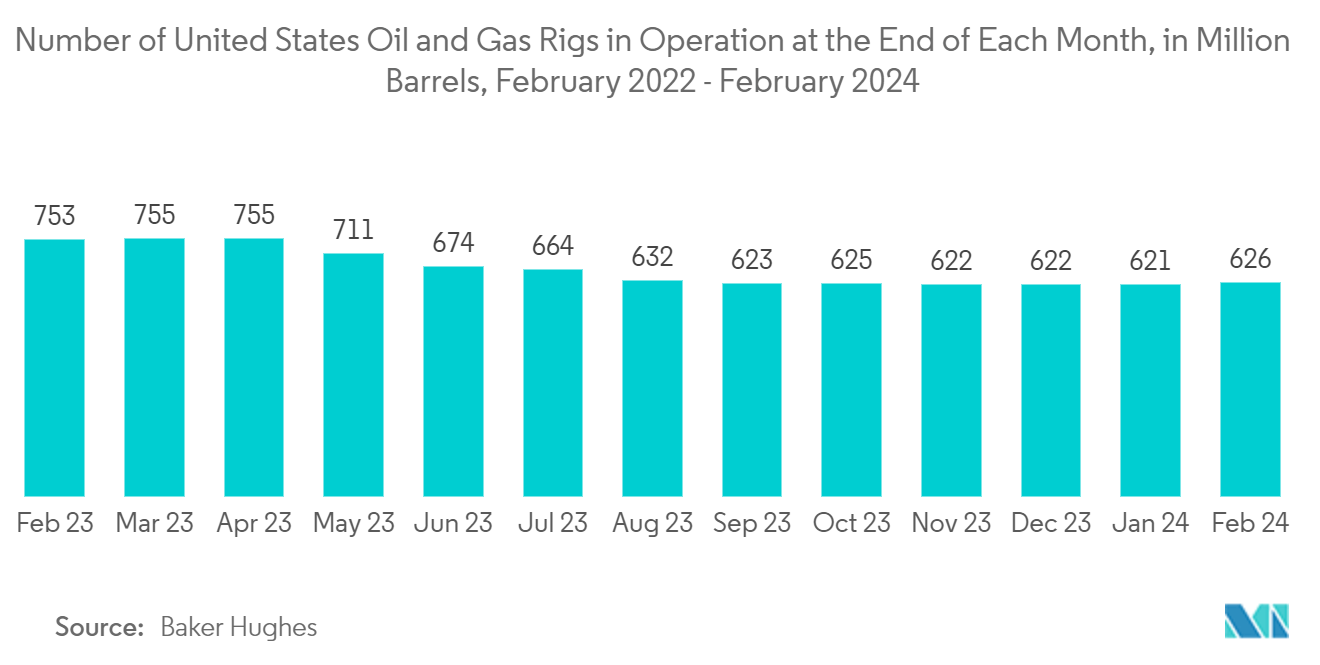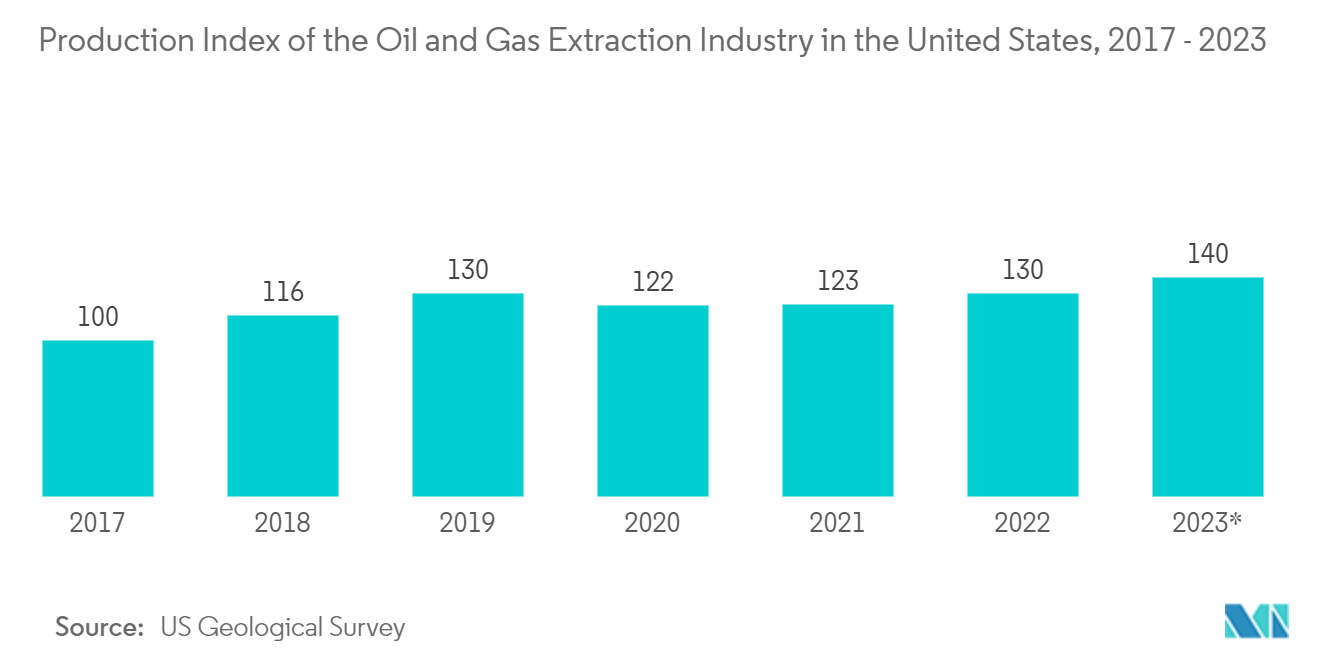Market Trends of North America Process Automation Industry
Oil and Gas Industry to Witness Significant Growth
- Automation is essential for propelling the oil and gas sector forward. By adopting automation, digitization, and advanced technologies, operators and technicians can promptly access vital performance, condition, and technical data. Process automation involves utilizing software and technologies to automate business processes and functions, ultimately achieving specific organizational objectives within the oil and gas industry. In the examined area, companies increasingly rely on process automation to enhance decision-making, troubleshooting, and overall performance.
- Automation is crucial in propelling the oil and gas industry towards progress. By adopting digitization, automation, and advanced technologies, operators and technicians gain instant access to vital performance, condition, and technical data. Companies in the examined region increasingly rely on process automation to enhance decision-making, troubleshooting, and overall performance.
- The oil and gas market is experiencing rapid growth, and automation plays a significant role in this industry's expansion. The United States, in particular, is witnessing a high demand for increased oil and gas supply, partly due to population growth in these regions. Supervisory control and data acquisition (SCADA) is a prevalent form of automation in the oil and gas sector. SCADA systems gather information and data from remote oil and gas locations, eliminating supervisors and personnel needing to visit these sites physically. The market's growth is anticipated to rise owing to the growing need for oil and gas and rising investments in the region's oil and gas sector.
- For instance, according to the US EIA, the United States has maintained its position as the top producer of crude oil globally for the last six years. By 2023, the average daily production of crude oil and condensate will hit 12.9 million barrels, exceeding the previous record of 12.3 million barrels set in 2019, both domestically and worldwide. The ample oil and gas supply in the country has reduced energy expenses, fostering investments in the private sector and bolstering economic expansion in the United States.
- Moreover, the revised climate strategy of the Canadian federal government sets forth a notable new goal to diminish greenhouse gas emissions. The plan's objective is to reduce emissions by 32-40% by 2030, aiming to achieve complete emissions neutrality by 2050. These targets play a vital role in mitigating the most severe consequences of climate change. The oil & gas industry, which accounts for over a quarter of Canada's total GHG emissions, has become a focal point for reduction initiatives. Such substantial initiatives are anticipated to increase the demand for automation technology in the oil and gas sector of the region, thereby promoting energy-efficient practices.
- The sector can improve production and distribution effectiveness by upgrading its internal procedures with automation and enhanced operational analytics, leading to increased yields. The industry's focus on safety and dependability is growing stronger. With the industry's intricate supply chain, there is an increasing interest in automation, specialized industry expertise, and intense collaborations. Process automation goes beyond efficiency; it represents a strategic decision to adapt to the constantly changing global market demands.

United States to Witness Major Growth
- The region is expected to contribute a significant portion of the market share. Fueled by Industry 4.0, the United States is strengthening its position on a global scale in factory automation and industrial control systems. The incorporation of intelligent technologies in this field not only improves operational effectiveness but also reinforces the country's economy. With the increasing interconnectedness of global manufacturing, American manufacturers are facing growing pressure to adopt automation. They are aiming and working towards achieving a balance between cost-effectiveness and elevated quality benchmarks.
- With the increase in cyber-attacks targeting U.S. smart factories, worries about Industrial Control Systems are growing. The government is implementing measures to address these dangers. At the same time, there is a noticeable trend towards using domestically produced industrial control systems as a strategic approach to reduce cybersecurity vulnerabilities in intelligent factories. Companies such as Panasonic North America are leading the way by providing extensive innovative manufacturing solutions including ERP systems and beyond.
- Significant investment is being made in infrastructure and the electronics industry as part of the Biden administration's economic recovery strategy post-pandemic. This bodes well for small and medium-sized enterprises, as the infrastructure and electronics sectors are major consumers of industrial control systems and are poised to benefit directly. Terms like process discovery, optimization, intelligence, and orchestration are gaining prominence in Robotic Process Automation (RPA). A clear trajectory towards deeper integration between business process management (BPM) and RPA exists.
- Stringent government regulations, exemplified by the Food Safety Modernization Act, are compelling food and beverage firms in the U.S. to adopt automation systems. This enhances the nation's automation market and streamlines operations, reducing costs and elevating product quality. Moreover, the increasing region's F&B industry capabilities is further expected to drive the market. The USDA stated that in 2023, the agriculture, food, and related industries made a contribution of around USD 1.530 trillion to the U.S. gross domestic product (GDP), accounting for a 5.6% share.
- Moreover, automation plays an important role in streamlining the various processes involved in the transmission, extraction, and refining of oil and gas within the industry. The United States is currently experiencing a notable surge in investments within the oil and gas sector, largely due to the escalating geopolitical circumstances. As per the U.S. Geological Survey, the production index for the oil and gas extraction industry in the United States is projected to reach an estimated 140 by 2023. This represents a substantial increase compared to the index of 100 in 2017 and 130 in 2022. These significant advancements are anticipated to drive the growth of this particular segment.


